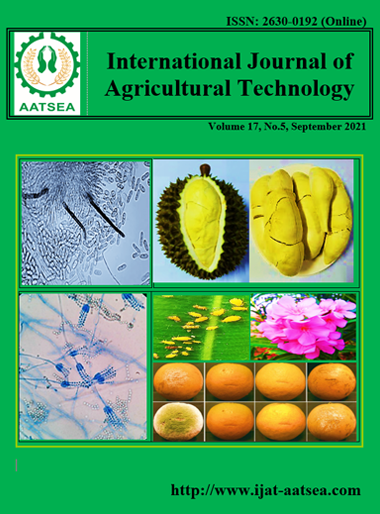Effect of insecticides and fungicides on arylamidase and urease activity in paddy soils
Main Article Content
Abstract
The effect of selected insecticides; carbosulfan, chlorpyrifos and fungicides; kresoxim-methyl, and mancozeb on two enzyme activities in paddy (black and alluvial) soils were recorded. The two soils were amended with lower to higher dosage (“1.0, 2.5, 5.0, 7.5, 10.0 kg ha-1”) of pesticides and incubated in the laboratory at 37oC for 40 days. Arylamidase and ureaseactivity was measured during the incubation at 10, 20, 30, and 40 days intervals. Carbosulfan, chlorpyrifos, kresoxim-methyl, and mancozeb stimulated the enzyme activity at lower concentrations at a 10-day interval. Striking improvement in the soil enzyme activities was noted particularly at 2.5 to 5.0 kg ha-1of pesticides and persisting for 30 days in both soils. Overall, higher concentrations (7.5 - 10.0 kg ha-1) of carbosulfan, chlorpyrifos, kresoxim-methyl andmancozeb were toxic or innocuous to the enzyme activities
Article Details

This work is licensed under a Creative Commons Attribution-NonCommercial-NoDerivatives 4.0 International License.
References
Acosta-Martinez, V. and Tabatabai, M. A. (2000). Arylamidase activity in soils. Soil Science Society of American journal, 64:215-221.
Asmar, F., Eiland, F. and Nielsen, N. E., (1994). Effect of extracellular-enzyme activities on the solubilization rate of soil organic nitrogen.Biology and Fertility of Soils, 17:32-38.
Barnes, H. and Folkard, B. R. (1951). The determination of nitrite. Analyst, 76:599-603.
Baum, C., Leinweber, P. and Schlichting, A. (2003). Effects of chemical conditions in re-wetted peats temporal variation in microbial biomass and acid phosphatase activity within the growing season.Applied Soil Ecology, 26:167-174.
Burns, R. G. (1982). Enzyme activity in soil: Location and a possible role in microbial ecology. Soil Biology and Biochemistry, 14:423-427.
Chen, S. K., Edwards, C. A. and Subler, S. (2003). The influence of two agricultural biostimulants on nitrogen transformations, microbial activity, and plant growth insoil microorganisms. Soil Biology & Biochemistry, 35:9- 19.
Das, S. K. and Varma, A. (2011). Role of enzymes in maintaining soil health. In Soil Enzymology; Shukla, G., Varma, A., Eds.; Springer-Verlag: Berlin, Germany, pp.25-42.
Fawcett, J. K. and Scott, J. E. (1960). A rapid and precise method for the determination of urea. Journal of Clinical Pathology, 13:156-159.
Floch, C., Anne-Celine, C., Karine, J., Yvan, C. and Steven, C. (2011). Indicators of pesticide contamination: Soil enzyme compared to the functional diversity of bacterial communities via BiologEcoplates. European Journal of Soil Biology, 47:256-263.
George, T. S., Richardson, A. E. and Simpson, R. J. (2005). The behavior of plant-derived extracellular phytase upon addition to soil. Soil Biology & Biochemistry, 74:367-385.
Hiwada, K., Yamaguchi, C., Inaoka, Y. and Kokubu, T. (1977). Neutral arylamidase in urine healthy and nephritic children.Clinica Chimica Acta, 75:31-39.
Jackson, M. L. (1971). Soil Chemical Analysis. Prentice-Hall India, New Delhi.
János, I., Szathmáry, L., Nádas, E., Béni, A., Dinya, Z. and Máthé, E. (2011). Evaluation ofelemental status of ancient human bone samples from Northeastern Hungary dated to the 10th century AD by XRF. Nuclear Instruments and Methods in Physics Research Section B Beam Interactions with Materials and Atoms, 269:2593-2599.
Nair, R., Varghese, S. H., Nair, B. G., Maekawa, T., Yoshida, Y. and Kumar, D. S. (2010). Nanoparticulate material delivery to plants. Journal of Plant Science, 179:154-163.
Rangaswamy, V. and Venkateswarlu, K. (1992). Effect of monocrotophos, quinalphos, cypermethrin, and fenvalerate on urease activity in groundnut soils. Environmental Ecology, 10:429-433.
Ranney, T. A. and Bartlett, R. J. (1972). Rapid field determination of nitrate in natural waters. Communications Soil Science Plant Analysis, 3:183-186.
Sannino, F. and Gianfreda, L. (2001). Pesticide influence on soil enzymatic activities. Chemosphere. Scientific research, 45:417-425.
Sinsabaugh, R. L., Lauber, C. L., Weintraub, M. N., Ahmed, B., Allison, S. D., Crenshaw, C., Contosta, A. R., Causack, D., Frey, S., Gallo, M.E., Gartner, T. B., Hobbie, S. E., Holland, K., Keeler, B. L., Powers, J. S., Stursova, M., Takacs-Vesbach, C., Wallenstein, M. D., Zak, D. R. and Zeglin, L. H. (2008). Stoichiometry of soil enzyme activity at global scale. Ecology Letters, 11:1252- 1264.
Srinivasulu, M. and Rangaswamy, V. (2013). Influence of insecticides alone and in combination with fungicides on enzyme activities in soils. International Journal of. Environmental Science Technology, 10:341-350.
Tu, C. M. (1981a). Effect of pesticides on the activity of enzymes and microorganisms in a clay loam soil. Journal of Environmental Science and Health, 16:179-181.
Tu, C. M. (1981b). Effect of some pesticides on enzyme activities in organic soil. Bulletin of Environmental Contamination and Toxicology, 27:109-114.
Villányi, I., Füzy, A. and Biró, B. (2006). Non-target microorganisms are affected in therhizosphere of the transgenic Bt corn. Cereal Research Communications, 34:105-108.
Xian, Y.; Wang, M. and Chen, W. (2015). Quantitative assessment on soil enzyme a`ctivities of heavy metal contaminated soils with various soil properties. Chemosphere, 139:604-608.
Yang, C., Sun, T., He, W. and Chen, S. (2006). Effects of pesticides on soil urease activity. Ying Yong Sheng Tai XueBao, 17:1354-1356.


